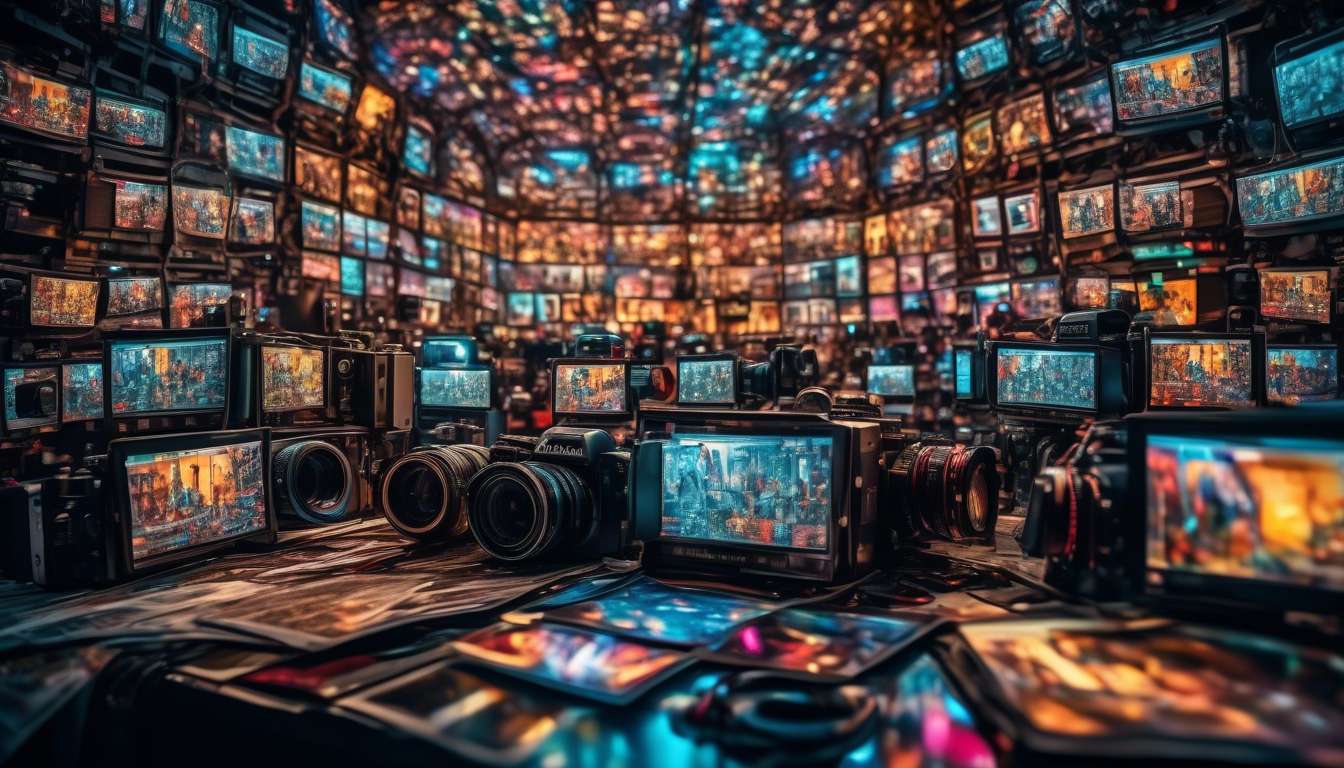In today’s fast-paced information age, we find ourselves constantly bombarded with news from every corner of the globe. Media coverage plays a pivotal role in shaping our perceptions of the world around us. We consume countless headlines and stories, often forming our opinions based on the narratives presented to us.
The power and influence of media narratives are significant. As a society, we must critically examine how media coverage affects our understanding of key issues, such as:
- Politics
- Social justice
By exploring the symbiotic relationship between media and public perception, we can better appreciate the responsibility both content creators and consumers share in fostering an informed and balanced view of the world.
Join us as we delve into the intricate dance between media influence and our collective consciousness.
The Role of Biases in Reporting
Biases in reporting significantly shape how audiences perceive and interpret news events.
As a collective, we often seek information that reaffirms our beliefs, and biases in media can distort our understanding, reinforcing divisions. When reporters frame stories through specific lenses, they emphasize certain details while omitting others, subtly guiding our interpretations.
This framing can lead to polarization, as we align ourselves with narratives that resonate with our values and perspectives. We find ourselves in echo chambers where media bias amplifies existing divides, impacting how we connect with one another.
Because we desire to belong and feel understood, we’re drawn to stories that validate our viewpoints. However, this can lead to a skewed perception of reality, as biases in reporting often highlight conflict and controversy over consensus and understanding.
By recognizing these biases, we can strive for a more balanced view:
- Seek diverse sources.
- Foster discussions that bridge gaps rather than widen them.
Together, we can challenge these biases and encourage media accountability.
Framing and Agenda Setting
Media Outlets and Public Discourse
Media outlets play a key role in shaping public discourse by deciding which issues to highlight and how to present them.
Framing and Its Influence
When we think about framing, we recognize the power media has in influencing our perspectives. By emphasizing certain aspects of a story and downplaying others, media can introduce bias that affects how we, as a community, interpret information. This selective presentation doesn’t just provide us with facts; it guides us in understanding them, sometimes steering us towards particular viewpoints.
Agenda Setting
Agenda setting goes hand-in-hand with framing. It determines which topics dominate our conversations and which are left in the shadows. When media focuses on specific issues, they drive our collective attention and concern.
Consequences of Media Influence
- This can lead to polarization, as we’re often exposed to narrow viewpoints that align with our existing beliefs.
Striving for Balance
In this shared space, it’s crucial for us to remain aware of these influences, striving for a balanced perspective that embraces diverse viewpoints and fosters unity.
Impact on Public Opinion
The media’s influence shapes public opinion by highlighting specific narratives and viewpoints, guiding how we perceive and react to the world around us.
We often find ourselves drawn to certain stories or perspectives not just because of their content, but due to the bias in framing these narratives. This framing can create a sense of belonging among us, as we align ourselves with particular ideologies or groups that share our values.
However, this can also lead to polarization, where differing viewpoints become more entrenched and divisive.
When media outlets choose to emphasize certain issues, they inadvertently impact our collective perception. We may adopt views that align with the narratives most frequently presented to us, often overlooking alternative perspectives. This selective exposure can intensify polarization, as we become more insulated within echo chambers that reinforce our existing beliefs.
As a community, we must:
- Stay aware of these influences.
- Strive to seek diverse sources.
- Engage in open dialogue to foster understanding.
By doing so, we can mitigate the impact of media bias and enhance our collective awareness and empathy.
Influence on Decision Making
Media Coverage and Decision-Making
Media coverage plays a crucial role in shaping how we make decisions by providing information that influences our priorities and choices. As a community that seeks connection and understanding, we know that the way issues are framed can lead us to interpret events differently.
Influence of Media Bias
When media outlets present information with a specific bias, it can subtly shift our perspectives, making some matters appear more urgent than others. We often find ourselves navigating a landscape where polarization is increasing, and it becomes challenging to discern which voices to trust.
Media Framing Effects
By highlighting certain aspects of a story while downplaying others, media framing can guide us toward particular conclusions. This framing affects not only our individual choices but also how we collectively approach pressing societal issues.
Strategies for Engaging with Media
We must remain aware of these influences by:
- Engaging with diverse perspectives
- Questioning the narratives we’re presented with
By doing so, we strengthen our decision-making processes and foster a more inclusive community.
Media’s Role in Social Change
Media outlets have a powerful capacity to drive social change by amplifying underrepresented voices and highlighting critical issues. Together, we can leverage this influence to foster a more inclusive and understanding society.
Impact of Story Framing:
- By choosing how stories are framed, media can either challenge existing biases or inadvertently reinforce them.
- We must be mindful of this framing to ensure it’s constructive and promotes unity rather than division.
Awareness in Media Consumption:
- As we consume media, certain narratives can lead to polarization within our communities.
- It’s crucial to stay aware of this tendency and seek out diverse viewpoints that bridge rather than widen gaps.
Role of Media in Community Empowerment:
- When media showcases stories that reflect our shared values and struggles, we feel a sense of belonging and empowerment.
- This motivates us to engage in positive social change.
Collective Responsibility:
- Let’s remember our collective responsibility to support media that emphasizes empathy and understanding.
- By doing so, we can help shape a media landscape that truly represents and uplifts us all.
Perception vs. Reality
Our understanding of the world is often shaped by media portrayals that don’t always align with reality. We find ourselves navigating a landscape where bias and framing play pivotal roles in how stories are presented.
It’s easy to feel connected to the narratives that resonate with us, but we must ask ourselves: Are these narratives genuine reflections of the world?
Media outlets often use framing to highlight certain aspects of a story while downplaying others. This creates a perception that might not fully represent reality. Such framing can lead to polarization, as we gravitate towards sources that echo our beliefs, reinforcing our sense of belonging within our chosen groups.
We need to recognize that while media provides valuable insights, it can also skew our understanding. By acknowledging these biases, we can strive for a more balanced perspective.
Let’s engage in conversations that:
- Challenge our views
- Embrace diverse perspectives
Fostering a community where we all feel understood and represented is crucial.
Echo Chambers and Polarization
In today’s digital age, echo chambers often reinforce our existing beliefs and contribute to societal polarization. As we navigate through social media and curated news feeds, we’re drawn to content that aligns with our views. This selective exposure amplifies bias, as we seldom encounter opposing perspectives.
The framing of news stories plays a crucial role in shaping our understanding, often highlighting specific angles that align with our preconceived notions.
When we’re in these echo chambers, it feels like we’re part of a community. We:
- Share
- Like
- Comment on content that resonates with us
This deepens our sense of belonging. However, this can lead to polarization, as differing views become more distant and less understood.
It’s important for us to recognize how these dynamics affect our perceptions. By acknowledging the impact of bias and framing, we can start to bridge the gaps that divide us and foster a more inclusive dialogue.
Strategies for Media Literacy
To enhance our media literacy, we must:
- Actively question sources
- Seek diverse viewpoints
- Critically evaluate the information we consume
By doing so, we can better understand how bias and framing shape narratives, often leading to polarization. It’s crucial that we don’t just passively absorb media but instead engage with it thoughtfully. Together, we can create a community that values informed discourse and mutual respect.
Let’s challenge ourselves to recognize bias in articles and broadcasts. By identifying these biases, we reduce the risk of being swayed by one-sided perspectives.
Framing is another tool that can distort our understanding. We must be aware of how stories are presented and consider what might be omitted.
In our pursuit of truth, let’s embrace diverse sources, ensuring we’re exposed to a broad spectrum of ideas.
As a united group committed to media literacy, we can break down barriers of misinformation and polarization, fostering a more connected and informed society.
How does media ownership affect the diversity of viewpoints presented in news coverage?
Concentration of Media Ownership
When media ownership is concentrated in a few hands, the diversity of viewpoints in news coverage can be limited. With fewer owners, there’s a risk that only certain perspectives get highlighted, potentially skewing the information presented to the public.
Impact on Public Perception
This lack of variety can hinder our ability to:
- See the full picture
- Make informed decisions
Importance of Diverse Voices
It’s crucial for a wide range of voices to be heard in news coverage to ensure:
- A balanced representation of different viewpoints
- An inclusive understanding of events and issues
What are the ethical considerations journalists face when reporting sensitive topics?
When we report on sensitive topics, we must navigate ethical considerations carefully.
Key principles include:
-
Ensuring accuracy:
- Verify facts thoroughly.
- Cross-check sources to maintain truthfulness.
-
Respecting privacy:
- Safeguard personal information.
- Avoid unnecessary intrusion into private lives.
-
Considering potential harm:
- Evaluate the impact of the information on individuals and communities.
- Strive to minimize negative consequences.
Balancing Rights:
- Journalists strive to balance the public’s right to know with individuals’ right to dignity. This involves making careful decisions about what to report and how to present it.
Maintaining Credibility:
- Upholding transparency is crucial.
- Avoid sensationalism to prevent misleading the audience.
- Seek diverse perspectives to provide a comprehensive view.
Responsibility in Reporting:
- Our responsibility is to report sensitively, ethically, and with integrity. This honors the impact of our work on society and maintains public trust.
By adhering to these principles, journalists can ensure their reporting is both responsible and impactful.
How do social media platforms contribute to the spread of misinformation?
Social media platforms contribute to the spread of misinformation by allowing unchecked sharing of unverified content. People often share without fact-checking, leading to the rapid dissemination of false information.
This can create confusion and influence public opinion. It’s crucial that we all take responsibility for verifying information before sharing to combat the spread of misinformation on social media.
Let’s work together to ensure accuracy and credibility in what we post and share.
Conclusion
In conclusion, media coverage plays a significant role in shaping public perception through biases, framing, and agenda setting. It has the power to:
- Influence public opinion
- Impact decision-making
- Contribute to social change
However, it’s crucial for individuals to be aware of the potential for echo chambers and polarization in media consumption.
Developing media literacy skills is essential for:
- Navigating the complex landscape of information
- Forming well-rounded perspectives
By enhancing media literacy, individuals can better understand and critically evaluate the information they receive, fostering a more informed and balanced view of the world.




